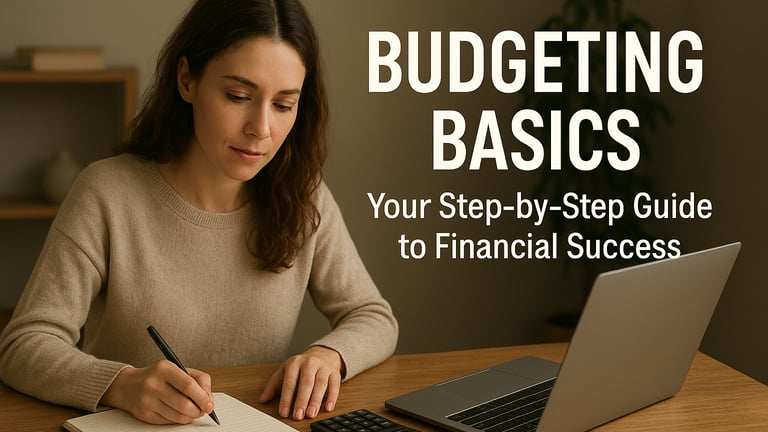Budgeting Basics: Your Step-by-Step Guide to Financial Success
Learn how to create an effective personal budget with this comprehensive guide. Discover practical strategies to manage expenses, save money, and achieve financial freedom. Perfect for budgeting beginners!
Edvaldo Ribeiro
10/17/20253 min read


Budgeting Basics: Your Step-by-Step Guide to Financial Success
Managing your money can feel challenging — especially when bills pile up, unexpected expenses appear, or you dream of big goals like buying a home or traveling the world.
The good news? A solid personal budget can be your roadmap to financial freedom.
In this guide, you’ll learn how to create and maintain a budget that truly works. Whether you’re a beginner or looking to sharpen your skills, here you’ll find practical tips, useful tools, and effective strategies to take control of your finances.
Why Budgeting Is Essential for Your Financial Future
A personal budget is more than a list of expenses — it’s a powerful tool for making conscious decisions with your money.
With a budget, you can:
Gain clarity: Know exactly where your money goes.
Reduce stress: Feel confident that your bills are paid and your savings are growing.
Reach goals: Save for your dream trip, an emergency fund, or debt repayment.
Build wealth: Make smarter financial choices to secure your future.
1: Understand Your Financial Situation
Before creating a budget, you need to know where you stand.
Calculate your income:
Include all sources:
Net salary
Extra income (freelance, side jobs)
Passive income (rent, dividends)
Other (pension, alimony)
If your income varies, use an average of the last 3–6 months.
Track your expenses:
Monitor every expense for one month using:
Apps like Mint or YNAB
Spreadsheets
A physical notebook
Categorize them as fixed (rent, bills) and variable (snacks, entertainment).
Set financial goals:
Write short-term (1–2 years) and long-term (5+ years) goals, such as:
Paying off debt
Building an emergency fund
Buying a car or house
Investing for retirement
2: Choose Your Ideal Budgeting Method
Everyone has a different style. Here are three popular ones:
50/30/20 Rule
50% for needs
30% for wants
20% for savings or debt
Simple and great for beginners.
Zero-Based Budget
Every dollar has a purpose. Example:
$2,000 = $1,000 rent + $500 groceries + $300 savings + $200 leisure
Perfect for those who like full control.
Envelope System
Distribute physical or digital money into categories. When it’s gone, stop spending. Great for avoiding overspending.
💡 Tip: Try the Financial Freedom Blueprint course to find your ideal method. It offers step-by-step guidance and ready-to-use templates.
3: Build Your Personal Budget
List your expenses
Fixed: rent, insurance, subscriptions
Variable: groceries, gas, entertainment
Irregular: gifts, maintenance, annual fees
Include savings and debt as “priority expenses.”
Set realistic amounts
Use your chosen method to distribute your income. Avoid overestimating or underestimating.Use tools to stay organized
Apps: Mint, YNAB, PocketGuard
Spreadsheets: Google Sheets, Excel
Printable templates: available in the Financial Freedom Blueprint course
Plan for irregular expenses
Create a separate fund for things like car maintenance or medical visits.
4: Stay Consistent
Weekly reviews:
Spend 10 minutes each week reviewing expenses and adjusting categories.
Automate everything:
Set automatic transfers for savings and payments to stay on track.
Have an emergency fund:
Build one covering 3–6 months of expenses. If you slip up, adjust and move on.
Visualize your progress:
Use charts and alerts in apps or spreadsheets. Seeing progress keeps you motivated.
Reward yourself wisely:
Include small rewards in your budget — stay focused without guilt.
Common Budgeting Mistakes (and How to Avoid Them)
❌ Ignoring small expenses
❌ Being too rigid
❌ Neglecting debt
❌ Forgetting irregular expenses
How Budgeting Solves Financial Pain Points
“I never have money left.” → Budgeting helps you prioritize.
“I’m afraid of emergencies.” → An emergency fund brings peace of mind.
“I can’t save.” → Clear goals boost motivation.
“I don’t know where to start.” → The Financial Freedom Blueprint guides you.
Boost Your Budget with the Financial Freedom Blueprint
This online course offers:
✅ Customizable templates
✅ Expert tips
✅ Community support
✅ Lifetime access
Perfect for anyone wanting to pay off debt, save for a home, or gain financial control.
👉 Click here to explore the course and start your journey.
Budgeting FAQs
How much should I save per month?
At least 20% of your net income (savings + debt repayment). Prioritize high-interest debts.
What if my income varies?
Base your budget on your lowest recent income. Build a 1–3 month buffer.
How big should my emergency fund be?
Start with one month of essential expenses, then grow to 3–6 months.
Should I pay debt or save first?
Pay off high-interest debt first. For smaller ones, split between saving and paying down.
Can I still have fun on a budget?
Yes! Include a leisure category.
How do I handle irregular expenses?
Create specific funds and contribute monthly.
What if I overspend?
Recalculate, adjust, and move forward. Learn from the mistake.
How often should I review my budget?
Weekly (10 minutes) + a full monthly review.
What tools help most?
Automation + simple tracking + progress visualization.
How do I stay motivated?
Set small goals, celebrate wins, and use checklists or support groups.
Take Control of Your Finances Today
Budgeting is the path to financial freedom. With discipline and the right tools, you can reduce stress, reach your goals, and build a secure future.
🎯 Ready to transform your financial life?
Start with the Financial Freedom Blueprint and create a budget that works for you.
💬 Which budgeting tip are you most excited to try?
Share your thoughts below!
Contact
Get in touch
Follow
Subscribe
+55-019-99927-3830
© 2025. All rights reserved.
